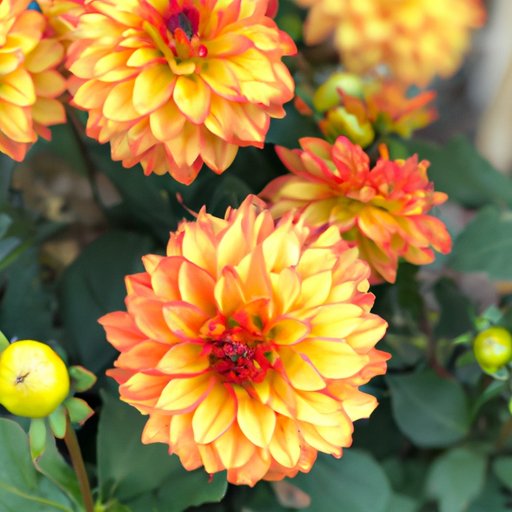

The Ultimate Guide to Mum Care: Keep Your Flowers Blooming
Do you want your mums to keep blooming year after year? Taking good care of your mums is the key, and it’s easy to do with the right knowledge. It’s always a pleasant sight to see the beautiful colors of mums in the garden or inside your home. In this article, we will give you an ultimate guide to mum care, including tips, expert advice, green thumb secrets, and DIY solutions to help you keep your mums healthy and blooming.
TIP 1: Watering Your Mums
One of the first things to understand about mums is that they need plenty of water. Water your mums frequently, but be sure not to overwater them. Overwatering can cause the roots to rot and kill your plants. So, it’s best to water them just enough, keeping the soil moist, but not too soggy. To check if your mums need water, stick your finger into the soil about 1 inch deep, and if it feels dry, it’s time to water. For outdoor mums, the frequency of watering may vary depending on the season, weather, and the amount of rainfall, so keep an eye on them and adjust accordingly.
TIP 2: Fertilizing Your Mums
Mums are heavy feeders, so they need nutrients to thrive and bloom. Use a slow-release, balanced fertilizer that is specifically made for mums, and apply it every few weeks during the growing season. For indoor mums, use a liquid fertilizer diluted to half-strength once a week. Be careful not to over-fertilize, as this can damage your plants and cause foliage burn. Additionally, if you notice that your mums are not producing blooms, this could be a sign that they need more phosphorus, which is essential for flower production.
TIP 3: Pruning Your Mums
Mums are known for their bushy and round shape, but to maintain this shape, you need to prune them regularly. Prune mums in the early spring or late fall to encourage branching and fuller growth. Remove any dead or diseased branches, and cut back about half of the plant’s height. This will stimulate new growth and a more compact shape. Additionally, pinch back the tips of your mums about every two weeks until July to promote branching and flowering.
TIP 4: Protecting Your Mums from Pests
Mums are susceptible to a variety of pests, such as aphids, spider mites, and thrips. To control and prevent these pests, use insecticidal soap or neem oil, which are natural and effective remedies to keep pests at bay. Make sure to read the instructions carefully and apply them according to the manufacturer’s recommendations. Additionally, keep an eye out for any signs of infestation, such as yellowed or curled leaves, and treat them promptly to prevent further damage.
TIP 5: Providing Adequate Sunlight for Your Mums
Most mums require full sun to flourish and bloom. Outdoor mums need at least six hours of direct sunlight daily, while indoor mums need bright, indirect light. If you notice that your mums are not blooming or are producing weak blooms, it could be due to insufficient sunlight. Move them to a sunnier spot, and they should perk up soon.
TIP 6: Preparing Your Mums for Winter
If you live in a region with harsh winters, your outdoor mums will need some extra care to survive. In the fall, stop fertilizing your mums and allow them to harden off. Water them less frequently, but don’t let the soil dry out completely. After the first hard frost, cut back the stems to about 2 inches above the ground, and cover your plants with a thick layer of mulch to protect the roots from freezing. In the spring, remove the mulch, and your mums should start growing again.
Mum Care 101: Expert Advice for Growing Gorgeous Blooms
Mums are relatively easy to grow, but there are some basic guidelines to follow to ensure success. Here are some expert tips on planting and caring for mums.
Planting Mums: Soil Preparation and Spacing
Before planting mums, prepare the soil by adding organic matter, such as compost or well-rotted manure, to improve drainage and fertility. Mums prefer a slightly acidic soil pH of 6.0 to 6.5 and good drainage. Space your plants about 1 to 2 feet apart, depending on their mature size.
Caring for Mums: Sunlight Requirements and Proper Watering
In addition to the tips we’ve already discussed, here is some additional expert advice for caring for your mums:
- Water your mums deeply once a week.
- Avoid getting water on the foliage, which can lead to fungal diseases.
- Mulch your mums to conserve moisture and regulate soil temperature.
- Provide good air circulation around your plants to prevent fungal diseases.
- Divide your mums every 2 to 3 years to rejuvenate them and maintain their vigor.
Green Thumb Secrets: Simple Tricks for Growing Perfect Mums
If you want to take your mum care to the next level, here are some simple tricks to try:
Prolonging the Bloom Time of Your Mums
Use a technique called “disbudding” to increase the size and number of flowers on each stem. Pinch off the side buds that form along the stem, leaving only the terminal bud to blossom. This will direct all the plant’s energy into one large, showy blossom. Additionally, deadhead spent flowers regularly to encourage more blooms.
Overwintering Mums for Next Year’s Display
One way to save money on plants is to overwinter your mums indoors in a cool, dark place, such as a basement or garage. After the first hard frost, dig up your outdoor mums and pot them up in containers. Water sparingly, and keep them in a cool place, where the temperature stays between 35 to 45°F. In the spring, move them back outdoors, and enjoy a dazzling display of blooms.
DIY Mum Care: Budget-Friendly Ways to Make Your Flowers Thrive
Mum care doesn’t have to cost a lot of money. Here are some DIY solutions to help your mums thrive:
Homemade Organic Fertilizers
Mix up your own organic fertilizer with ingredients you already have on hand, such as compost, bone meal, and coffee grounds. Simply mix equal parts of each ingredient and apply it to your mums once a month during the growing season.
Do-It-Yourself Insect Repellents
To keep pests away from your mums, try making a homemade insect repellent using garlic and hot peppers. Finely chop a few cloves of garlic and a hot pepper, and steep them in a gallon of boiling water overnight. Strain the liquid, and spray it on your mums to repel aphids, thrips, and other common pests.
Low-Cost Watering Solutions
Instead of buying expensive watering cans or hoses, try using a plastic milk jug or a drip irrigation system made from recycled materials. Simply poke holes in the jug or hose, and place it near your mums, and the water will slowly seep out, providing a steady supply of moisture to your plants.
Troubleshooting Mum Problems: Tips for Dealing with Common Issues
Even with the best care, problems can still arise with your mums. Here are some tips for dealing with common issues:
Yellowing Leaves
If your mums’ leaves are turning yellow, it could be a sign of overwatering or nitrogen deficiency. Adjust your watering schedule, and apply a high-nitrogen fertilizer to correct the problem.
Wilting Flowers
If your mums’ flowers are wilting, it could be due to underwatering or heat stress. Water your plants deeply, and provide some shade during the hottest part of the day to prevent further stress.
Insect Infestations
If you notice pests on your mums, such as aphids or spider mites, try spraying them with a neem oil or insecticidal soap solution. If the infestation is severe, you may need to remove and dispose of the affected plants to prevent the pests from spreading.
Mum Magic: Unconventional Ways to Enhance Your Flower Power
If you’re feeling adventurous, here are some unconventional ways to enhance the beauty of your mums:
Using Unusual Containers for Your Plants
Instead of planting your mums in traditional pots or planters, try using unusual items, such as old teapots, watering cans, or boots, to add some whimsy and charm to your displays.
Pairing Mums with Complementary Flowers
To create a stunning garden display, pair your mums with other complementary flowers, such as asters, black-eyed Susans, or ornamental grasses. This will add dimension and interest to your garden and create a striking visual effect.
Creating Vertical Displays
If you’re short on space, try creating a vertical display of mums by hanging them in baskets or using a trellis to support them vertically. This will not only save on ground space but also create a beautiful and unique garden feature.
Conclusion
Caring for mums is easy with the right knowledge and techniques. Water your mums frequently, fertilize them, prune them regularly, protect them from pests, provide them with adequate sunlight, and prepare them for winter. Use expert advice, green thumb secrets, and DIY solutions to take your mum care to the next level. And don’t forget to troubleshoot common problems and explore unconventional ways to enhance your flower power. With these tips in mind, you can enjoy beautiful and blooming mums year after year.




